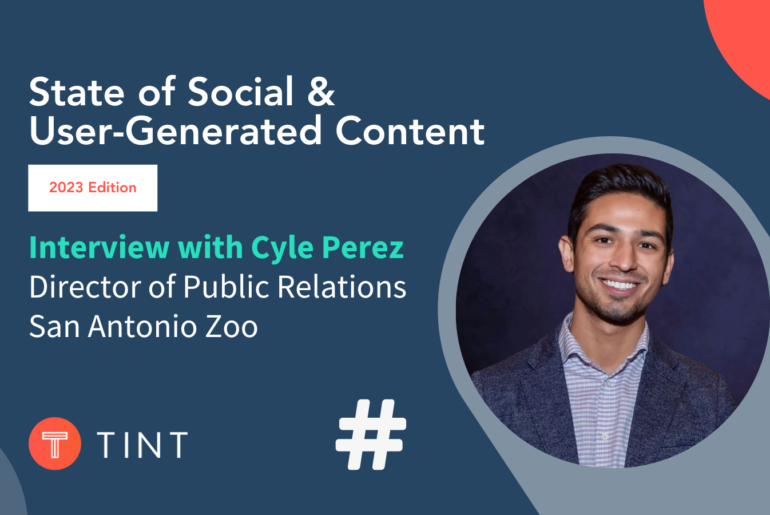Marketing, like everything else, is constantly evolving; there are peaks in trends, strategies, and types of media that we use to market to our audience. This past century alone has brought us television commercials, email marketing, and online ads. And as marketing moves through these trends and evolutions, there will be certain audiences that help push it along. Millennials are a prime example.
We hear a lot about how millennials are impacting the world, and this is particularly true when it comes to marketing. Millennials make up 25% of the US population, and make up 21% of consumer discretionary purchases, giving them more than a trillion dollars in direct buying power. Millennials are also believed to be a big influencer on older generations. Because of this, you need to know how to market to the selfie generation, or you risk having your marketing efforts fall flat.
Understanding Millennials
In order to market to millennial users, you first need to understand them.
US Millennials are more engaged with digital technology than any other generation has been before; they are frequent users of social media, and spend increasing amounts of time on mobile devices.
Some important facts to consider about Millennials include:
- Millennials are currently spending over 25 hours a week online
- Only 1% of Millennials said a compelling advertisement would make them trust a brand more
- 43% of Millennials value authenticity over content when consuming news, meaning they need to trust a source before they’ll trust the information being shared
- Experts believe that the human attention span is shrinking; with so much content just a click away, it’s easy to find something different, fast
- While scouring the internet for valuable content, Millennials are also likely to share the content they find across social media, increasing its visibility further
With more options available to them, and with a value on authenticity and content over pure product promotion, Millennials’ enormous impact is changing the face of marketing as we know it.
RIP Traditional Advertising
Millennial aren’t responsive to traditional forms of advertising; instead, they openly reject it, and typically only respond to content that resonates with them. Because of this, traditional advertising isn’t nearly as effective as it once was.
Before social media, commercials and print ads reigned supreme; up until I left for college, the television commercial was the primary method I used to discover new products. Then Facebook started booming, and Twitter, and then Youtube; fast forward six years, and I now find products on Pinterest and research them on blogs. The marketing platforms I’m least likely to be influenced by? Traditional advertising.

Recognizing that its traditional marketing techniques weren’t cutting it anymore, Coca-Cola updated its marketing strategies to adapt to Millennial users. See more examples of how to do this at TINT.
Television commercials and print ads are much less effective on Millennials, and they’re consumed less and less every day; we have DVR and Netflix now instead of watching live TV, and we consume most content online (and even on social media) instead of print.
Most importantly, the spammy BS we’re all familiar with that practically oozes that sleazy jalopy salesman vibe is no good; Millennials can spot that crap a mile away, even if it’s hidden on social media. If you’re overtly trying to sell them on something, they’ll go running far, far away, and they might even bring their 5,000 closest Facebook friends with them.
Digital Marketing Does Work + User-Generated Content (UGC)
Here’s the good news: while traditional marketing strategies and media are pretty much out, digital marketing can still work. You just have to adapt your strategies to meet the marketing trends Millennials will respond to.
We’ve discussed above that Millennials value authenticity more than anything else; they need to trust a brand before they’ll engage with or purchase from it, but it can be difficult to earn their trust. The best way to build rapport with Millennials and win them over, therefore, is to show them that other users trust you, too.
Examples of digital marketing strategies that are effective with Millennials include:
Sharing UGC or user-generated content, is one of the best strategies you can use to gain the trust of new users; it’s also a great tactic to increase engagement and rapport with users that already follow you on social media. In fact, 84% of Millennials say UGC matters when they’re researching a brand or a product before purchasing.

Digital marketing can work and be highly effective across all generations– including Millennials; you just need to have the right strategy in place. Implementing UGC, as shown in the image above, is one of the best strategies you can use, as shown on TINT.
Sharing content that was created by users works as social proof and acts as that user’s vote of approval. Very few users, after all, would take a picture of themselves utilizing a brand’s product if they hated it. Sharing UGC also shows users that you value their input, which builds the relationship further between you and your followers.

This UGC shared on Instagram garnered a ton of engagement; Modcloth regularly features UGC to similar results.
- Online reviews. Reviews on sites like Yelp, Urban Spoon, and Facebook carry a heavy weight in the eyes of Millennials. It comes down to users trusting other users more than they trust brands. This makes sense- what brand would say “you know, we’re ok, but this other sushi joint is slightly higher quality and for a fraction of the cost,” instead of showcasing their awards front and center?
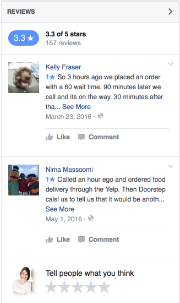
Reviews go a long way in the eyes on Millennials, so maintaining a high quality of service is important.
- Social Media Engagement. More and more Millennials (along with users in other generations) are using social media sites to research products and brands instead of the brands’ websites. They’re using Facebook as a search engine, and it makes sense; from Facebook, they can see how the brand interacts with users, how users interact with the brand, any up-to-date news or information, and reviews written by users.

Engaging with your users publicly and showing you’re invested in their engagement goes a long way.
Encourage users to engage with you on social media, and make sure you respond and interact with them when you do. Adding social sharing prompts to your site and implementing both UGC and social media engagement CTAs can help increase both.

Social sharing buttons and CTAs and massively drive up engagement on social media, including inspiring the generation of new UGC that you can share later.
Social media marketing thrives on transparency, or at least the illusion of it, allowing users to believe they’re really getting to know a brand and what it stands for. This is important to gaining the trust, engagement, and loyalty of Millennial users.
How to Connect with Millennials
While social proof reigns supreme with Millennials and on social media in general, this isn’t always the best news for small brands who are just starting to build up their followers and their social media and online presence. Fortunately, there are several other methods that you can use to increase your followers and engagement, connecting with interested Millennials along the way.
You can connect with Millennials by:
Staying relevant
Millennials are interested in what’s happening right now. Provide content that’s relevant and timely, and take advantage of trending topics to connect with more of your audience. You can use promoted posts on Facebook and trending topics or promoted tweets on Twitter to make sure your relevant content connects with users at its peak engagement time. Soon, we’ll be able to run promoted posts on Instagram, too.
On Instagram and Twitter, find relevant hashtags on trending topics and jump in to connect with more users and participate in the conversation quickly. Twitter will even show you some in their trending topics section.
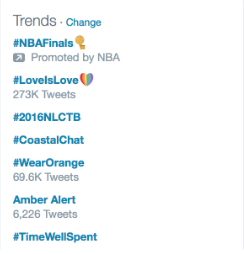 Tell real stories
Tell real stories
Millennials don’t care about your product placement; instead, we want to see real people. Nothing connects with Millennials more than real stories about real people. With most Millennials being willing to spend a little more on a product that they believe in, this is particularly important.
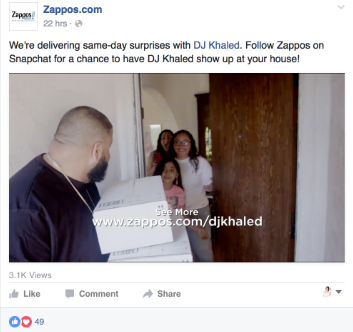
Caption: Zappos shared a video featuring an influencer surprising real people, tugging at the heartstrings.
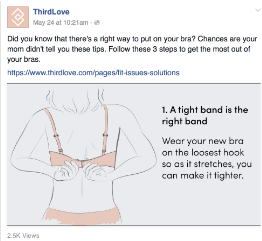
Always offer value
There is a time and place for product promotion, and social media isn’t really the place. While you can feature some of your products in different places, the majority of your content (both on social media and your blog) should be about offering value to the user, whether through entertainment or education. Instead of writing a post about six features of your new exercise equipment that you’re trying to sell, write a post about six different exercises users can complete for strength training; if the post features the equipment, that’s fine, but it shouldn’t be the obvious focus.
Caption: ThirdLove provides content of value to their users, like how to wash their bras without damaging them and to extend the life of their bras.
If you make it all about you, Millennials won’t care. When you don’t, however, you can offer value that Millennials will respond to.
For more examples on how to apply these strategies to your marketing campaigns and to connect better with Millennials with UGC and valuable content, you can check out our gallery here.
Final Thoughts
The marketing world is changing, and Millennials have a lot to do with that. Since Millennials hold so much purchasing power and a heavy influence on older generations, they should never be ignored in your marketing efforts. Adding more content that focuses on users and engagement with them can help increase your success when marketing to Millennials.
If you want to learn about how TINT can help you connect with Millennials and implement UGC, feel free to reach out and we’d love to strategize with you!


 Tell real stories
Tell real stories
